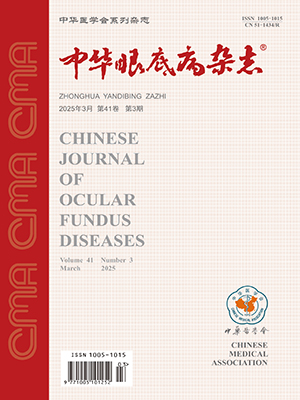| 1. |
Lopez NN, Clark AF, Tovar-Vidales T. Isolation and characterization of human optic nerve head astrocytes and lamina cribrosa cells[J/OL]. Exp Eye Res, 2020, 197: 108103[2020-06-06]. https://pubmed.ncbi.nlm.nih.gov/32522476/. DOI: 10.1016/j.exer.2020.108103.
|
| 2. |
刘晓晴, 周雪美, 原慧萍. 青光眼对视神经筛板的影响[J]. 眼科学报, 2020, 35(6): 436-441. DOI: 10.3978/j.issn.1000-4432.2020.12.11.Liu XQ, Zhou XM, Yuan HP. Effect of glaucoma on optic nerve lamina cribrosa[J]. Yan Ke Xue Bao, 2020, 35(6): 436-441. DOI: 10.3978/j.issn.1000-4432.2020.12.11.
|
| 3. |
王余萍, 袁源智. 青光眼视神经损害机制[J]. 中国临床医学, 2016, 23(5): 667-671. DOI: 10.12025/j.issn.1008-6358.2016.20160290.Wang YP, Yuan YZ. The mechanism of optic nerve damage in glaucoma[J]. Chinese Journal of Clinical Medicine, 2016, 23(5): 667-671. DOI: 10.12025/j.issn.1008-6358.2016.20160290.
|
| 4. |
张纯, 吴倩如, 张頔, 等. 青光眼性视神经损伤的非压力依赖因素[J]. 中华眼科杂志, 2020, 56(7): 549-556. DOI: 10.3760/cma.j.cn112142-20190922-00480.Zhang C, Wu QR, Zhang D, et al. Non-pressure dependent factors of glaucomatous optic nerve injury[J]. Chinese J Ophthalmol, 2020, 56(7): 549-556. DOI: 10.3760/cma.j.cn112142-20190922-00480.
|
| 5. |
刘旭阳, 樊宁. 局灶性筛板缺损对青光眼进展的影响[J]. 中华眼科杂志, 2020, 56(1): 17-20. DOI: 10.3760/cma.j.issn.0412-4081.2020.01.007.Liu XY, Fan N. The effect of focal lamina defect on the progression of glaucoma[J]. Chin J Ophthalmol, 2020, 56(1): 17-20. DOI: 10.3760/cma.j.issn.0412-4081.2020.01.007.
|
| 6. |
杜绍林, 郑文凯, 董秀清, 等. 青光眼角膜生物力学与视盘生物力学的关系[J]. 中山大学学报(医学版), 2019, 40(6): 938-945. DOI: 10.13471/j.cnki.j.sun.yat-sen.univ(med.sci).2019.0129.Du SL, Zheng WK, Dong XQ, et al. The relationship between corneal biomechanics and optic disc biomechanics in glaucoma[J]. Journal of Sun Yat-sen University(Medical Sciences), 2019, 40(6): 938-945. DOI: 10.13471/j.cnki.j.sun.yat-sen.univ(med.sci).2019.0129.
|
| 7. |
吴建, 王宁利. 筛板结构及影像学研究进展[J]. 国际眼科纵览, 2019, 43(5): 300-305. DOI: 10.3760/cma.j.issn.1673-5803.2019.05.003.Wu J, Wang NL. Research advances in structure and imaging of lamina cribrosa[J]. Int Rev Ophthalmol, 2019, 43(5): 300-305. DOI: 10.3760/cma.j.issn.1673-5803.2019.05.003.
|
| 8. |
张婷, 李龙, 宋凡. 青光眼发病机理—筛板变形研究进展[J]. 力学学报, 2019, 51(5): 1273-1284. DOI: 10.6052/0459-1879-18-321.Zhang T, Li L, Song F. The pathogenesis of glaucoma—research progress on sieve plate deformation of lamina cribrosa[J]. Chinese Journal of Theoretical and Applied Mechanics, 2019, 51(5): 1273-1284. DOI: 10.6052/0459-1879-18-321.
|
| 9. |
张地, 刘向玲, 宋子宣, 等. 原发性急性闭角型青光眼大发作缓解后视盘参数变化[J]. 眼科新进展, 2019, 39(7): 682-685. DOI: 10.13389/j.cnki.rao.2019.0157.Zhang D, Liu XL, Song ZX, et al. Changes in optic disc parameters after remission from a major attack of acute angle-closure glaucoma[J]. Rec Adv Ophthalmol, 2019, 39(7): 682-685. DOI: 10.13389/j.cnki.rao.2019.0157.
|
| 10. |
李略, 卞爱玲, 程钢炜, 等. 增强深部成像相干光断层扫描术观察原发性开角型青光眼视乳头筛板的形态学变化[J]. 中华眼科杂志, 2016, 52(6): 422-428. DOI: 10.3760/cma.j.issn.0412-4081.2016.06.006.Li L, Bian AL, Cheng GW, et al. Analysis of morphologic changes of lamina cribrosa in primary open angle glaucoma using enhanced depth imaging optical coherence tomography[J]. Chin J Ophthalmol, 2016, 52(6): 422-428. DOI: 10.3760/cma.j.issn.0412-4081.2016.06.006.
|
| 11. |
孙云晓, 谢媛, 刘祥祥, 等. 自发性局限性筛板缺损与青光眼视神经损伤进展的关系[J]. 中华眼科杂志, 2019, 55(5): 338-346. DOI: 10.3760/cma.j.issn.0412-4081.2019.05.007.Sun YX, Xie Y, Liu XX, et al. Spontaneous focal lamina cribrosa defect in glaucoma and its relationship with nonprogressive glaucomatous neuropathy[J]. Chin J Ophthalmol, 2019, 55(5): 338-346. DOI: 10.3760/cma.j.issn.0412-4081.2019.05.007.
|
| 12. |
Sun Y, Guo Y, Cao K, et al. Relationship between corneal stiffness parameters and lamina cribrosa curvature in normal tension glaucoma[J/OL]. Eur J Ophthalmol, 2020, 18: 1120672120982521[2020-12-18]. https://pubmed.ncbi.nlm.nih.gov/33334173/. DOI: 10.1177/1120672120982521.
|
| 13. |
中华医学会眼科学分会青光眼学组. 我国原发性青光眼诊断和治疗专家共识(2014年)[J]. 中华眼科杂志, 2014, 50(5): 382-383. DOI: 10.3760/cma.j.issn.0412-4081.2014.05.022.Glaucoma Group, Ophthalmology Branch of Chinese Medical Association. Expert consensus on the diagnosis and treatment of primary glaucoma in my country (2014)[J]. Chin J Ophthalmol, 2014, 50(5): 382-383. DOI: 10.3760/cma.j.issn.0412-4081.2014.05.022.
|
| 14. |
Won HJ, Sung KR, Shin JW, et al. Comparison of lamina cribrosa curvature in pseudoexfoliation and primary open-angle glaucoma[J]. Am J Ophthalmol, 2021, 223: 1-8. DOI: 10.1016/j.ajo.2020.09.028.
|
| 15. |
Kim JA, Lee EJ, Kim TW, et al. Differentiation of nonarteritic anterior ischemic optic neuropathy from normal tension glaucoma by comparison of the lamina cribrosa[J/OL]. Invest Ophthalmol Vis Sci, 2020, 61(8): 21[2020-07-01]. https://pubmed.ncbi.nlm.nih.gov/32668001/. DOI: 10.1167/iovs.61.8.21.
|
| 16. |
Loiselle AR, Kleine E, Van DP, et al. Intraocular and intracranial pressure in glaucoma patients taking acetazolamide[J/OL]. PloS one, 2020, 15(6): e0234690[2020-08-18]. https://pubmed.ncbi.nlm.nih.gov/32555666/. DOI: 10.1371/journal.pone.0234690.
|
| 17. |
肖春婷, 吴瑜瑜. 筛板青光眼性病理及跨筛板压力差在视神经损害中研究进展[J]. 中国实用眼科杂志, 2015, 33(4): 332-336. DOI: 10.3760/cma.j.issn.1006-4443.2015.04.002.Xiao CT, Wu YY. Research progress of lamina glaucoma pathology and transmembrane pressure difference in optic nerve damage[J]. Chin J of Pract Ophthalmol, 2015, 33(4): 332-336. DOI: 10.3760/cma.j.issn.1006-4443.2015.04.002.
|
| 18. |
郝琳琳, 肖辉, 陈翔熙, 等. 原发性开角型青光眼与原发性慢性闭角型青光眼活体筛板厚度和筛板前表面深度的比较[J]. 中华眼底病杂志, 2016, 32(6): 619-623. DOI: 10.3760/cma.j.issn.1005-1015.2016.06.013.Hao LL, Xiao H, Chen XX, et al. Comparing the lamina cribrosa in eyes with primary open angle glaucoma and chronic primary angle closure glaucoma[J]. Chin J Ocular Fundus Dis, 2016, 32(6): 619-623. DOI: 10.3760/cma.j.issn.1005-1015.2016.06.013.
|
| 19. |
Sun Y, Guo Y, Xie Y, et al. Inter-eye comparison of focal lamina cribrosa defect in normal tension glaucoma patients with asymmetric visual field loss[J/OL]. Ophthalmic Res, 2020,2020:E1[2020-11-10].https://doi.org/10.1159/000512925.DOI: 10.1159/000512925. [published online ahead of print].
|
| 20. |
Hopkins AA, Murphy R, Irnaten M, et al. The role of lamina cribrosa tissue stiffness and fibrosis as fundamental biomechanical drivers of pathological glaucoma cupping[J]. Am J Physiol Cell Physiol, 2020, 319(4): C1258-C1233. DOI: 10.1152/ajpcell.00054.2020.
|




